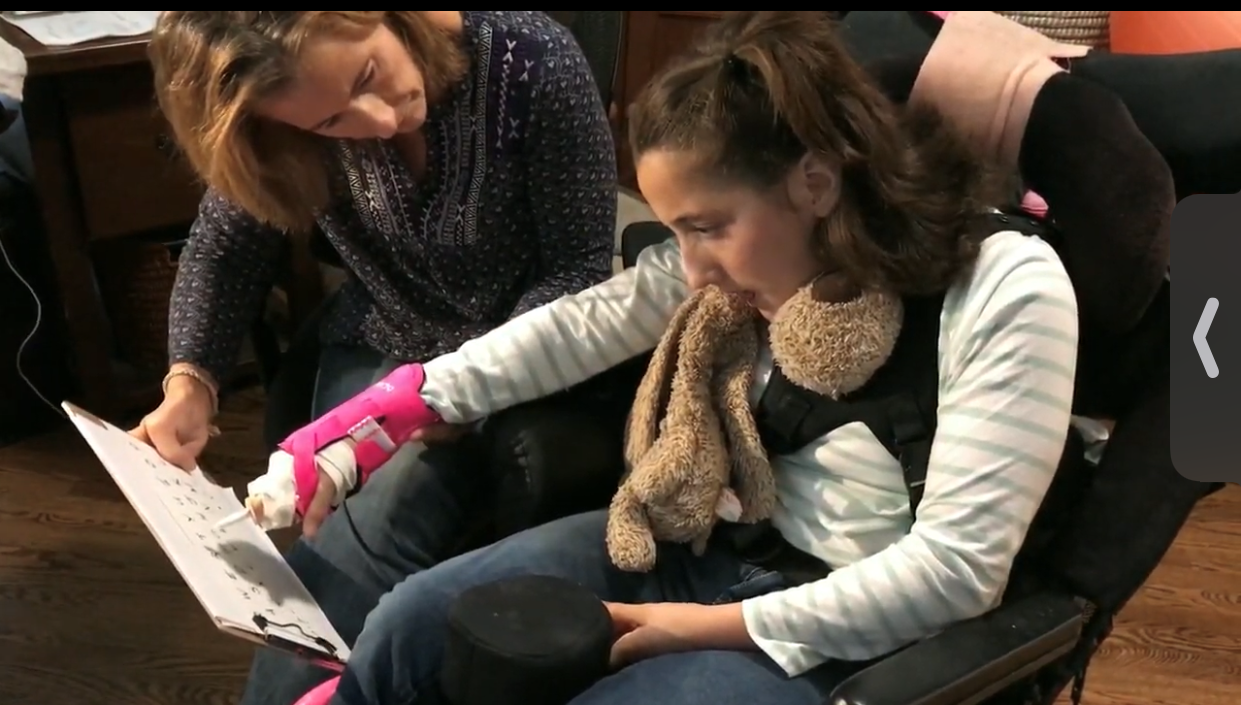Susan discusses the mother-daughter writing collaboration of The Year of the Buttered Cat
by Susan Haas
Haircuts available NOW! the sandwich board sign teased.
I hadn’t had a proper haircut in months. I stood on the sidewalk in front of the salon, my 6-year-old business partner staring up at me from her wheelchair. Using words (mine), gestures, squeals, and groans (mostly hers), we negotiated the terms of our contract:
Simple cut, no highlights but yes, a blow dry and style.
Strawberry ice cream after. One. Scoop.
Okay, Fine. Multicolor sprinkles.
But now the deal was falling apart. Through a curtain of wet hair, I could see Lexi twisting and writhing in her wheelchair. I knew loud groans weren’t far behind.
“It won’t be much longer, Lexi,” I said, trying hard to keep my head steady as the stylist snipped at my bangs. “Do you need a different view for a while?”
Lexi stuck out her tongue—her way of saying yes.
I stuck out a leg and slowly turned the wheelchair with my foot. Lexi’s body relaxed.
The stylist stopped snipping and shook her scissors at me. “I saw you doin’ this outside. Is she usin’ magic to talk?” She shook her scissors at me. “Magic’s the devils work. We don’t allow magic in here.”
Lexi was now laughing in sharp heaving sighs and I knew that at this moment she was Harry Potter and the stylist was Harry’s prickly Aunt Petunia.
Thankfully, we avoided an official reprimand from the Ministry of Magic that day, but it wasn’t the first time nor the last that our family’s communication with Lexi would be misunderstood.
People don’t understand what they can’t see, and that has never been more evident than when trying to explain our writing process. The truth is, writing with Lexi isn’t magic. It’s just plain hard work with plenty of MacGyvering to use whatever muscle control she has to our advantage.
My writing sessions with Lexi begin with comprehensive planning. She has a clear communication of yes and no (the tongue thrust for yes and a low growl for no) along with a handful of articulated words and body gestures that all of us in her immediate family understand. We use all of these as we sit together and “talk” out a scene or story.
Once the framework is sorted, Lexi and I work on content. She uses a combination of pointing to letters on a board and—while still an emerging skill for her—a computerized eye gaze communication device she has named Haha.
Lexi’s body and her eyes move constantly, which can make writing on Haha difficult. “She writes well,” might wind up on her computer screen as “Sgheee werruites wekll.” Deciphering the meaning of her sentences can be a challenge, especially when she is having what she calls a “bad body day.”
Pointing to letters on a board feels more natural to Lexi, probably because this was how her writing emerged. Sitting in my lap and with support at her elbow or wrist, ten-month-old Lexi could drag magnetic letters around a metal cookie sheet and spell. She’s too big to hold in my lap like this now, but I can brace her arm and hold up a board with printed letters. This is more accurate but excruciatingly tedious. It’s how she wrote her author’s note at the end of The Year of the Buttered Cat, but that took over a month to get on paper. Obviously, writing an entire book this way isn’t practical.
Once we get our main thoughts out together, I type up the scene, then Lexi and I talk it out. And wow does this girl have strong opinions! Laughing, screeching, pointing, and head shaking all let me know immediately if she agrees or disagrees with the treatment. If she disagrees, we go back to the beginning of the process and work out what she wants changed. Sometimes it’s an action sequence or a description or a detail I left out that she thinks is important, but more often than not, she wants changes to her voice. She knows exactly how she should sound—obviously-- and if I have it wrong, she wants it fixed.
We work together until everything is how Lexi wants it. Usually this is only a couple of revisions, but once an editor gets involved (in our case, the insightful and lovely Ariel Felton at Penelope Editions) the revision process isn’t just about what Lexi wants, but what the editor (vis a vis the reader) wants. Those revisions can take many more drafts to get right, and this is a learning process for both me and Lexi. Emotional scenes, like the reveal near the end of the Buttered Cat where I tell Lexi what happened to her as a baby, can be especially hard to work through, leaving us both frazzled and ready for a long run (me) or an afternoon of YouTube bingeing (Lexi).
One day, I hope you can read about Lexi entirely in her own words. Maybe computer brain interfaces will become practical and reliable enough to give Lexi and every person with a communication disorder the chance to tell their story. But until that day, Lexi and I will use our not-so-magic process to show the world just how much a person who can’t talk has to say.
Watch The Year of the Buttered Cat trailer:

